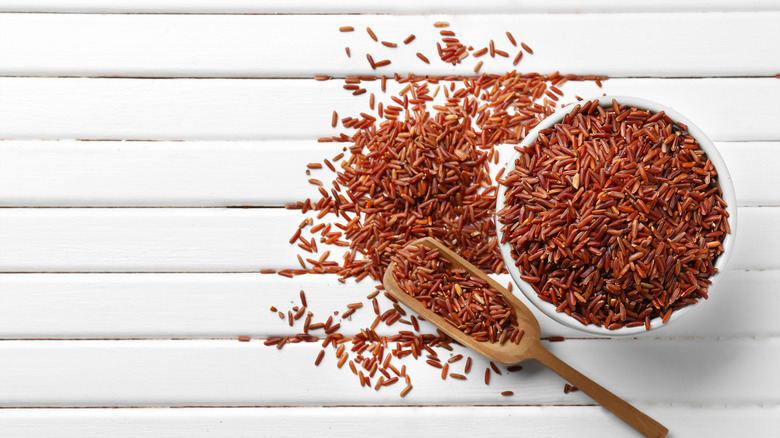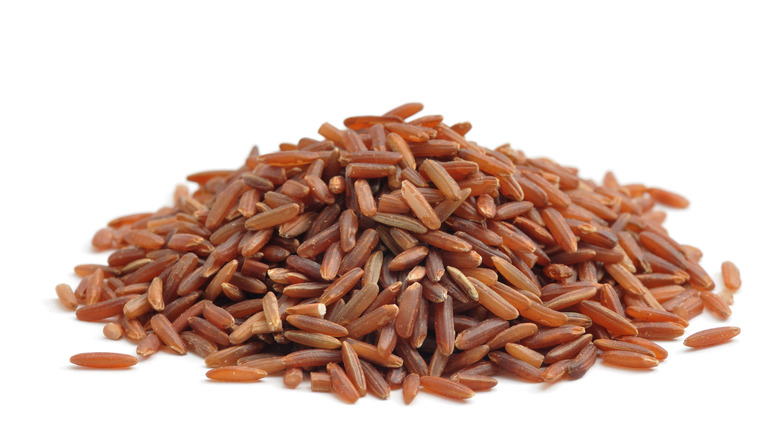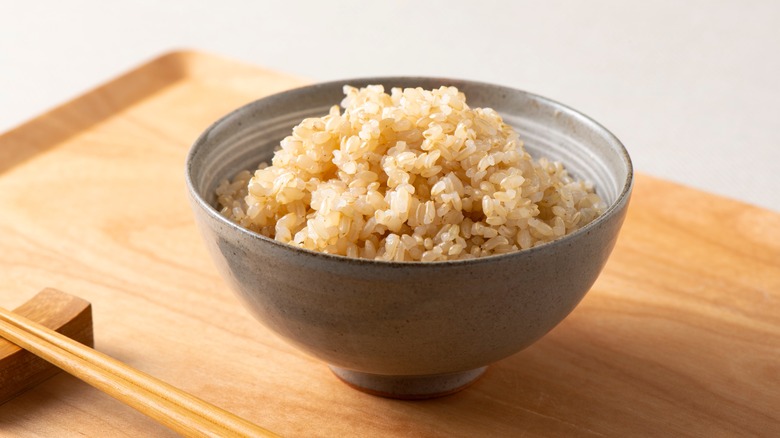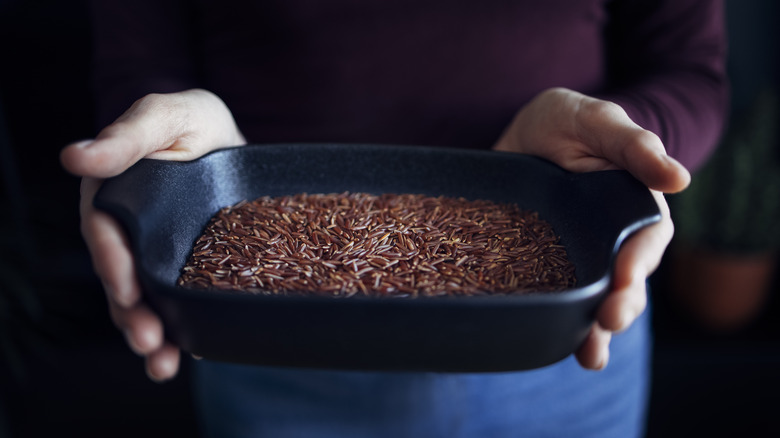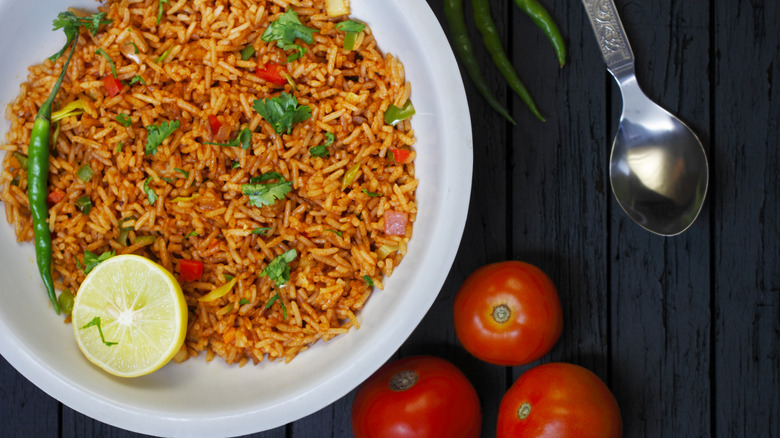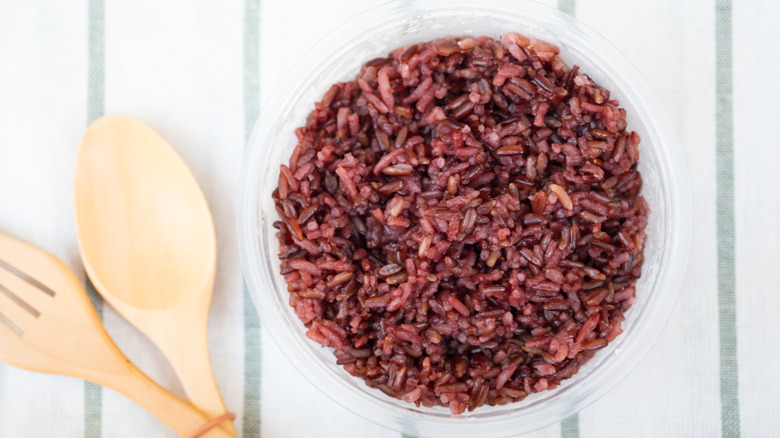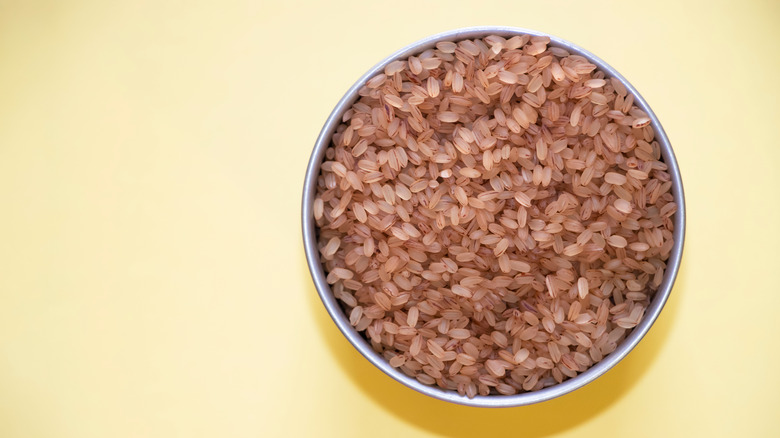What Is The Best Method For Cooking Red Rice?
We may receive a commission on purchases made from links.
Beyond just the white and brown varieties, rice can show up in all the colors of the rainbow. Unlike purple rice, which gets its signature bright violet color from combining black and white grains, or healthy green rice, which is coated in a veggie sauce, whole grain red rice (Oryza sativa or Oryza glaberrima) naturally boasts its signature burnt sienna hue.
Just like brown rice, the red version can take a while to cook. If you have a rice cooker, you're in luck, as this is typically the most hands-off way to get fluffy red rice. All you have to do is dump your rice, water, oil, and a pinch of salt in the device, stir it up, and let it cook on the brown rice setting. Of course, you can also use a stovetop pot. Once you've got water boiling in a pot with your rice and a little bit of oil, cover with a lid, reduce to low heat, and let it simmer until all the liquid is absorbed, about 45 minutes.
You don't have to soak your rice before you cook it, but you may want to if you're using the stove. In that case, try soaking for at least two hours to reduce your cooking time by about 20 minutes — but make sure to dump the water out and use a fresh batch when you're ready to heat.
What is red rice?
So what makes red rice red? Its defining characteristic is that it's rich in an antioxidant called anthocyanin, which gives the bran its signature reddish-brown color. In case you're unfamiliar with the anatomy of rice, the bran is the outer shell of the grain — this is where the food's nutrients, antioxidants, and anti-inflammatory properties primarily lie, according to the National Cancer Institute. Red rice isn't the only food that contains anthocyanin. The pigment also gives berries, currants, grapes, and other foods their various shades of red, purple, or blue.
The term "red rice" encompasses quite a few different varieties. Thai, Bhutanese, and West African types may be some of the more popular ones. The scientific name for red rice, and rice in general, is Oryza sativa or Oryza glaberrima — the former is considered Asian rice, while the latter refers to African rice. Both types are still grown today, although Asian rice is much more widely cultivated. However, red varieties can also show up as Oryza rufipogon, Oryza longistaminata, or Oryza punctata.
Red rice vs. brown rice
Although brown and red rice can come in multiple varieties, they often both come as whole grains, meaning their bran outer shell is fully intact. Just like with red rice, this means that the brown variety comes with plenty of nutrients and health benefits. Brown rice contains fiber, thiamine, niacin, magnesium, and phosphorus, among other vitamins and minerals. Healthline notes that it can help lower blood sugar, reduce risk of heart disease, and help with weight loss. Just like red rice, the brown type is high in antioxidants and has a low glycemic index.
However, while buying brown rice almost always means you're getting a whole grain, it's more common to see red rice that is partially milled. In this case, you're still left with some of the bran and germ. While brown rice turns white when fully milled (or beige when halfway milled), the red version becomes a brighter red, or pink when cooked. Whole-grain red and brown rice typically take longer to cook than partially polished red varieties, and all of these will take longer than white rice.
What does red rice taste like?
Whole grain red rice is typically chewy on the outside but soft on the inside once fully cooked. Partially polished versions may be even more tender once fully cooked due to some of the bran's removal. Just like brown rice, it has a nutty flavor along with a delightfully nutty smell. In addition to its earthiness, red rice has subtly sweet notes that make it taste slightly more sugary than other types of rice.
However, compared to some types of rice, red versions can have a relatively one-note flavor. Chinese black rice, for instance, has a fruity and floral flavor profile while Jade pearl rice, which is used in sushi and desserts, smells like bamboo and has a sweet vanilla flavor. Red grains are generally earthier and nuttier than these types, although the exact flavor can vary a little depending on the type of red rice.
How to cook with red rice
Once you've sufficiently cooked red rice, you can use it to make all kinds of sweet and savory dishes. It's popular in a variety of Indian foods, from Khichdi (a meal made with lentils), to Kheer (a sweet pudding), to Puli Pachadi (a side dish made with lentils and vegetables). It can even be made into a paste and paired with roasted veggies.
You can also try using Bhutanese rice (also known as Himalayan red rice) to make popular foods from Bhutan. These include Ema Datshi, a spicy stew made with chili peppers and onions, and Jasha Maroo, a dish composed of chicken, garlic, onion, ginger, and tomato. Or, try whipping up Zow Shungo, which is essentially just made of leftover veggies and red rice.
However, you can also substitute red rice for white or brown in just about any savory recipe, keeping in mind that you'll get a nutty and slightly sweet flavor. Try using it in a pilaf like this saffron rice pilaf recipe, as a bottom layer for a rice bowl like gyudon, or as a base for a pork fried rice. For an extra pretty boost of color, feel free to experiment with pink rice. You can either cook partially milled red rice, which turns pink when cooked, or mix cooked red and white grains together.
Where to buy red rice
Depending on where you live, red rice may be popular enough that you can find it at major grocery stores. For instance, you can get it at Vons, Albertsons, and Walmart. Keep in mind that it's more common to see whole grain red rice in big chains like these. It may be possible to find partially polished bags as well, but check the package label to make sure it's the type you're looking for.
If you're not having any luck at stores like these, try visiting specialty food stores or Asian or African markets. And when in doubt, head to Amazon to get your fix — it sells everything from Bhutanese to Thai red rice and even has bags grown in the south of France, also known as Camargue red rice. If you know exactly what variety of the grains you'd like and can't find it at Amazon or a specialty store, you can also try visiting markets' websites. For instance, Woodland Foods sells Himalayan red rice, and Flavors of Ceylon sells a double-polished bag.
Nutritional information about red rice
Red rice is packed full of nutrients, although whole grain versions will have a higher nutritional value than partially polished bags. Whole grain red rice is high in zinc, calcium, and iron — and of course, anthocyanin, the antioxidant that gives it a reddish-brown color. In fact, it contains a whopping 10 times as many antioxidants as brown rice, along with plenty of magnesium, selenium, phosphorus, thiamine, riboflavin, and fiber (via NDTV Food).
Unsurprisingly, this means that red rice comes with a plethora of potential health benefits. Per Health Shots, the grains can help lower glucose levels and have a low glycemic index, so they're a beneficial option for people with diabetes. PharmEasy also shares that red rice can also reduce cell inflammation, slow down breast cancer cell growth, and potentially help combat hair loss. It may even assist with lowering cholesterol, and its fiber can help keep you full while aiding digestion. It has long been used in ancient Indian medicine (also known as Ayurveda) as a nutritional powerhouse.
On the flip side, you may want to be careful with over-consuming red rice, especially if you're just starting to introduce it in your diet. If undercooked, it can actually cause stomach pain and indigestion, states NetMeds.
Different varieties of red rice
Although all versions of red rice look fairly similar, they have slightly different tastes and textures and may come from completely different parts of the world. Red cargo rice, also known as Thai red rice, is considered non-glutinous, which indicates that it's not sticky when cooked. It's sometimes referred to as cargo rice because back in the day, it used to be exported in mass quantities. The grains tend to be longer with a deeper red hue.
Oryza punctata, also known as dragon red rice, typically has a brighter red or even pinkish-red color. This is a variety of African rice that can be found growing in South Africa, tropical Africa, and Madagascar. And if you want to try a type specific to India, go with Kerala Matta red rice, also called Rosematta, Palakkadan Matta, or Red parboiled rice. Grown specifically in Kerala in Southwest India, it's known to be a little rougher than other types but just as nutrient-dense. If it's parboiled, Kerala Matta rice is typically gluten-free.
And if you're looking for an earthy, sticky red rice, try Bhutanese or Himalayan types — their medium-length grains are typically sold partially polished.
